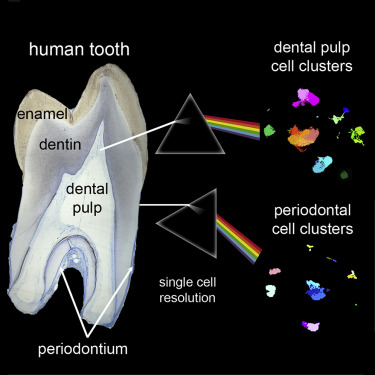An interesting article titled “A single-cell atlas of human teeth” written by Pierfrancesco Pagella et al. appears in iScience (vol. 24, no. 102405, May 21, 2021). In the article the researchers analyzed five wisdom teeth that had been extracted to conduct a comprehensive single-cell atlas of the human tooth. The cells studied came from these five wisdom teeth and were extracted by dentists in Zurich. Isolating the cells from these wisdom teeth may have introduced variability between samples and some cells may not have survived the isolation process. Even so, the study found novel insights into how stem cells work which could help answer questions in regenerative medicine.
In the study, the researchers at the University of Zurich and ETH Zurich used single-cell RNA sequencing to investigate cells present in dental pulp and the periodontium. The researchers compared patterns of gene activity, to help identify different cell types that exist in each tissue. They found that the stem cell populations can be put into groups based on their gene activity. Both dental pulp and periodontium stem cells express the same markers, including Thy-1 cell surface antigen (THY1/CD90), myosin heavy chain 11 (MYH11), and C-C motif chemokine ligand 2 (CCL2).
The authors found that dental pulp consists mostly of fibroblasts, which are cells common in connective tissue. The periodontium has more epithelial cells, which line the surfaces in the body, than that of dental pulp. These cells also did not behave the same way in the the dental pulp as in the periodontium and produced different sets of molecules that may control how the stem cells behave. Periodontal fibroblast cells showed an increase in gene activity linked to collagen production and turnover. The authors said that the cellular and molecular signature of the periodontium identified in this study was indicative of its continuous and dynamic remodeling and explains its role in absorbing the shocks from chewing.
The differences found between the cells in the dental pulp and the periodontium were more minor than the researchers expected and the cells were similar in most regards. The variation in the behavior of the stem cells is due to the conditions within the tissues rather than intrinsic genetic differences. This finding can have profound effects on research efforts to enhance the regenerative capabilities of stem cells.

The authors feel their study provides an unprecedented understanding of the composition of the dental pulp and periodontium tissues, which are subject to tooth-specific and bacterially-linked pathologies such as periodontitis and caries (cavities). This research is the first to compare the cell populations of the dental pulp and periodontium in the human tooth.
Using the technology to evaluate single cells could help uncover new insights into dental diseases. Single-cell approaches can help uncover the interactions of dental pulp and periodontal cells involved in immune responses when bacteria invades. Single-cell analysis could be useful for diagnostic purposes to support the early detection of dental diseases. The authors state:
“Taken together, our findings provide a thorough investigation of the human pulp and periodontal tissues at single-cell resolution, thus representing the basis for future research involving cell-based regenerative treatments.”
Saving wisdom teeth to preserve stem cells has been covered on this site before such as in the post Storing Wisdom Teeth Stem Cells. It seems that researchers are now closer to understanding the secrets of the stem cells that wisdom teeth have. Perhaps one day they could be used to help heal damaged parts of the human body.
